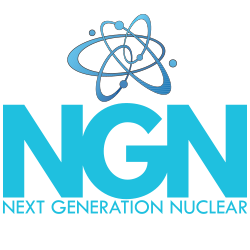

Green sources or renewable energy sources are those that are naturally replenished when used. Solar, wind, and hydro are considered renewable in most countries, natural gas and nuclear are also considered renewable in others.
Nuclear is not dependent on intermittent sources such as the sustained force of wind, the amount of sunlight per day, or available water sources suitable for hydropower. All so-called “green solutions” each have their own large scale negative environmental impacts. Many, if not all of these negative impacts are often left out of discussions about our energy needs. In turn, this leads many to believe “green” options are without consequences. This is false. Solar, Wind, Hydro, Natural Gas (NG is considered green energy by the European Commission), etc. all have their disadvantages and should be considered when informing all stakeholders of their energy source options.
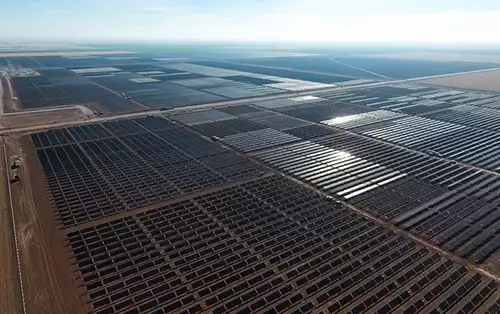
When looking at solar there are, of course, residential, and industrial applications. Residential installation of solar panels is by far the largest option of all the other alternative sources of energy.
Efficiency, as one would expect, is extremely important when considering solar for either situation.
Staring with residential, the best solar panels on the market provide ~22.8% efficiency, industrial might get up to 40% per some reports. However, we have not been seeing this in practice at the world’s largest solar installations which typically operate in the ~20% range.
It may seem counterintuitive, but temperature impacts a solar panels performance negatively. For every degree above 77 degrees Fahrenheit (25 Celsius) maximum power drops by .258%. Materials, placement, and geographic location can reduce or increase this impact.
Consider this. If we compare a 1,000-megawatt nuclear facility looking at land requirements we would use little more than a square mile for a nuclear plant. In order to generate the same energy from a comparable solar farm would need 3 million solar panels and 75 times more land.
How many species being relocated or killed per year is an acceptable amount to utilize this land and low efficiency energy source? The Ivanpah Solar plant (392 MW) which occupies 5 square miles in California incinerates up to 6,000 birds per year, not counting those that crash into the panels. In addition, it required the relocation of the official reptile of both Nevada and California the Gopherus agassizii. Since 1950 this species population has crashed by some 90%, translocation of the tortoise as all those involved are aware, does not work, and they are certain to die.
All this for 18% efficiency at Ivanpah? and they still require a natural gas backup to aid during cloudy days.
But at least we can recycle those panels when they are unusable right?
Wrong. As recently as March 21, 2022, the United States Department of Energy solar researchers determined the cost of recycling would be as economic as sending the scrapped panels to a landfill. It’s estimated by 2050 solar panels could make up 10% of all electronic waste.

Land usage is one of the largest drawbacks to this form of renewable energy coming in at a massive 360 times more land required than a nuclear plant that yields the same power, or about 430 wind turbines.
Much like the solar panels association with bird deaths, wind turbines are responsible for the deaths of bats and migrating birds. According to the United States Geological Survey its estimated hundreds of thousands of bats die annually in North America alone. Until 2018 there was no national database of where these turbines existed, so these numbers are relatively new with much more study necessary.
Like solar, this source of energy is not continuously available. The electrical output is dependent on wind speed, air density, turbine characteristics etc. Wind speed must be above (generally) 3.5 m/s (meters per second) approximately 7.8 mph in order to generate electricity, but below 25 m/s, approximately 56 mph to avoid turbine damage. Efficiency is another concern; the Environmental Protection Agency notes commercially available wind turbines are ~20% - 40% efficient with a lifespan of 20 years. They continue with the fact that ice in cold climates can result in turbine failure or be thrown for great distances creating a potential health hazard. In addition, Researchers have found that the buildup of insects killed by turbine blades can reduce the electricity they generate by 50 percent.
Unfortunately, much like solar panels when turbines reach the end of their lives most end up in landfills. With the tallest US onshore turbines coming in at 175 meters (574 feet) nearly half the height of the Eiffel Tower the land requirements for wind energy continue to increase.

Although Hydroelectric does provide a high degree of efficiency ~80% in some cases, it comes with tremendous costs to the environment. In order to have hydroelectric power, dams must be constructed. It is well documented the impact dams have on sediment transport, fish migration, nutrient distribution etc. Less known by the general public, is when an area is flooded in order to create a reservoir it creates stagnant water that kills vegetation releasing large amounts of carbon dioxide and methane. The increase in these gases is not only a negative for the atmosphere but can cause plant life below the surface to rot creating hypoxic conditions unsuitable for some aquatic organisms.
This source of energy also has wide scale human impacts. Residents are forced off their property, and although compensated it often pales in comparison to the loss of their way of life. Failures of dams have caused wide scale death and destruction. The Banqiao Dam in China failed and killed an estimated 171,000 people. The most recent failure in 2017 was in California. The Oroville Dam failed during the wettest winter California experienced in a century. The result was 64 deaths, 180,000 people evacuated and nearly $400 million in repairs.
Hydroelectric is also susceptible to drought, negatively impacting energy production and there are extremely limited resources to construct these facilities. Obviously, you cannot build a dam anywhere, there are currently 90,000 dams in the United States with less than 3% in possession of facilities for electricity generation. Most locations that were deemed suitable for hydroelectric dams have already been used for this purpose.

Biomass is not carbon neutral as some would suggest. The rate at which the carbon is released by the burning (not including the growing, harvesting, transportation, and conversion into pellets) far outpaces the amount of carbon absorbed by the growing of trees taken for this purpose. The use of animal and human waste escalates the amount of methane released, and the pollution from burning wood and other natural materials can be as bad as burning traditional energy sources.
It should come as no surprise that large scale tree harvesting can and does lead to deforestation. Also, the desire for fast growing trees as fuel leads to monoculture agriculture. This practice leads to a loss in biodiversity, a disruption in the natural balance of soils and puts the entire crop at risk to pests and disease. The increased risk of pests and disease in turn leads to a dependance on higher levels of chemicals to keep them in check, which of course, have their own negative environmental impacts.
In addition, biomass land requirements are in direct competition for land, water and capital needed for growing food, the same with biofuels. Nearly 40 meals are taken off the table for every gallon of biofuel created, or to put it another way, filling up an SUV (25 gallon tank) with biofuel needs over 450 pounds of corn, enough to feed a person for a year.
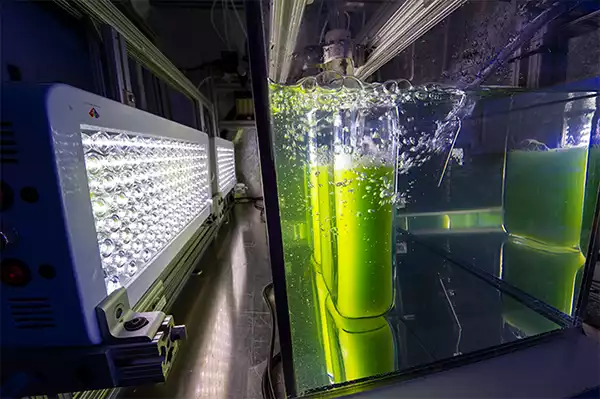
Relatively new to the public, is the possibility of another biofuel in this case created by algae. A benefit of algae based biofuels unlike those created using corn, these algal fuels are not competing with any food requirements, they can be grown on unsuitable land for traditional farming (requiring 10-300 times less space), grown in either the presence or absence of sunlight and grown in saltwater or even wastewater. Some of the benefits of this resource are its carbon neutral, some species can double their numbers in 24 hours, it’s a versatile source and produces numerous byproducts such as fertilizers and feedstocks.
Unfortunately much like other types of farming there are large fertilizer demands. Some estimates put the fertilizer requirements for large scale aquaculture such as this at 15% of all produced fertilizer per year. The negatives associated with fertilizer are well known as are its extensive energy requirements and linked emissions. There are thousands of species of algae, their oil production is not consistent and currently the process is complicated and expensive for refinement. Perhaps the largest drawback is the algae grown in ponds has an enormous water demand, far more than other biofuels. So far the majority of experiments have focused on small scale operations and more in depth study is needed and certainly will be conducted.
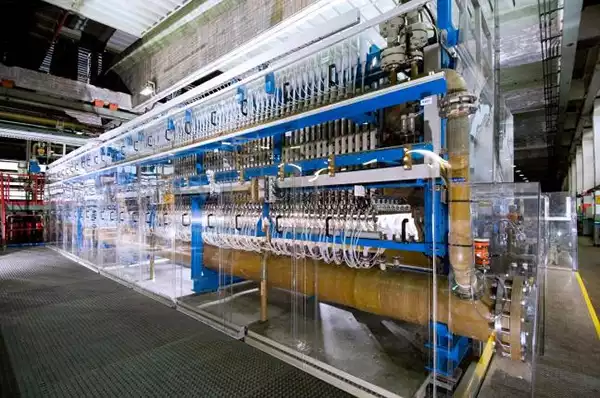
Hydrogen is a clean fuel that, when used in vehicles, produces only water vapor when consumed. In comparison to gasoline, hydrogen has approximately twice the fuel economy. It’s also a renewable source that as long as its being produced has virtually no chance of being depleted. At this point there are more negatives associated with hydrogen than the positives. In fact, many of the positive qualities are immediately countered when examined more closely. For example, when looking at use in vehicles, either cryogenic or high-pressure tanks are required and pose serious practical issues. Another claim is that hydrogen greatly reduces pollution and is environmentally friendly. This is highly dependent on how the hydrogen is created. It’s a fact that hydrogen is one of the most found elements in the universe along with nitrogen and oxygen. It’s also very abundant and the most basic of all Earth elements, but it doesn’t exist in free form and must be liberated from water or methane molecules. In effect, this means we have to produce it using a technique called electrolysis (often referred to as water splitting).
Electrolysis comes with large energy requirements, most of the time this is fossil fuel based and puts out enormous carbon emissions. Using nuclear power will be the way to produce large amounts of hydrogen from a clean energy source at affordable prices. Nuclear currently can create hydrogen electrolytically and advanced reactors will create it in the future thermochemically. Then and only then can we consider hydrogen to be a clean source of energy, the other challenges for transportation and storage remain.
Geothermal energy is a sustainable resource created from the slow decay of radioactive particles deep within the Earth and the core, such Uranium and Thorium. The primary types of geothermal power plants include: Direct dry steam, Flash - Double flash cycle and Binary Cycle. Dry steam plants pipe hot steam directly from the ground to turbines. Flash steam plants pull deep hot water into low pressure tanks where it flashes to steam to drive turbines. Binary cycle plants pass moderately hot water through a heat exchanger, vaporizing another liquid such as isobutane (a hydrocarbon) which turns the turbines. Unfortunately there are large land requirements associated with their construction as well as the potential release of GHG’s such as silica and sulfur dioxide, and some reservoirs contain heavy metals like boron, arsenic and mercury. Fracking is another concern, and an intrinsic part of a geothermal power plant’s construction.
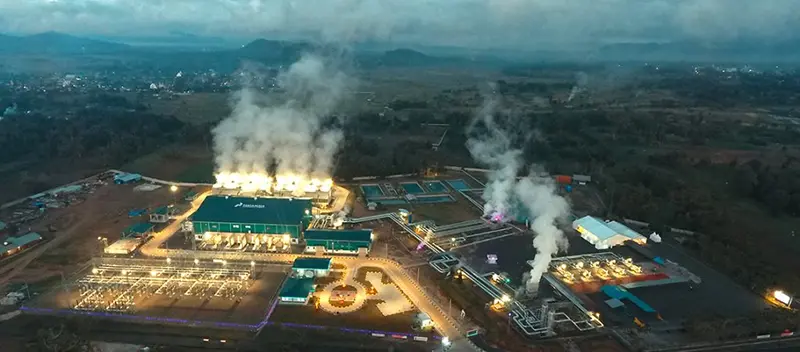
The majority of geothermal in the United States is taken from the Imperial Valley region of California. On any given day a typical geothermal plant located here produces ~40 tons of radioactive waste, every day. This translates to 200 times the volume of radioactive waste per watt than a typical (in use today) nuclear reactor would produce. Looking closer at the waste generated, this same plant produces ~410 tons of production brine per day which after removing the solids is then injected into the Earth. The solid waste is considerable, as of 2010 the disposal site in Imperial Valley County contained 400,000 cubic feet (816,000 tons) which is approximately 20 years worth of operation. This site is 100,000 square meters with a waste depth of 4 meters with an additional 2.4 meters of soil added in an attempt to reduce associated radon emissions.
The reality is, scientists have yet to create or discover anything even close to hydrocarbons. There are no other sources in respect to high-energy density, low-cost, transportable, reliable energy.
Consider the following when looking at renewable energy sources:
If we were to spend $1 million on utility scale wind or solar projects over 30 years of operation they would produce ~50 million kWh. Spending the same amount of money on a shale rig would yield enough natural gas to generate ~300 million kWh over the same 30 years. It’s true that wind and solar have made significant gains in both costs and efficiency. However, the 10 fold gains are over as these technologies have ran into physics boundaries. The Shockley-Queisser Limit demonstrates a maximum conversion of 34% photons into electrons in respect to solar. With wind turbines, the Betz Limit has provided the maximum capture of 59.3%. Neither of these technologies capture anywhere close to those figures at the present time.
When considering intermittent sources of energy, storage of produced energy is vital in order to provide power when production is unavailable or greatly reduced due lack of source e.g., after dark, cloudy weather, little wind, drought etc.
Here are two examples of what energy storage from renewable sources could look:
Tesla is perhaps the largest and most well known name in electric vehicles and energy storage. The Tesla Gigafactory which is currently under construction in Nevada, when completed, is expected to be the largest building in the world. This facility could store about 3 minutes worth of the annual demand of electricity in the United States. In order to reach two days worth of storage, there will need to be ~1000 years of production (at current rates) to create the batteries required. During the construction of the Gigafactory for every pound of battery produced, 50-100 pounds of material will be mined, processed and transported, all with serious negative consequences.
Another option in order to provide backup power to the United States grid is multiple storage centers, we will need 15,280 of these storage centers. These centers would need to be the size of Escondido, CA which is about 37.45 square miles costing an estimated $764 billion. These centers will provide backup power that will last only 4 hours, again the land usage and associated environmental impacts would be staggering. As with other “green solutions” there are many concerns with what, if any, of the countless batteries and other materials required would be recycled and at what percentage.